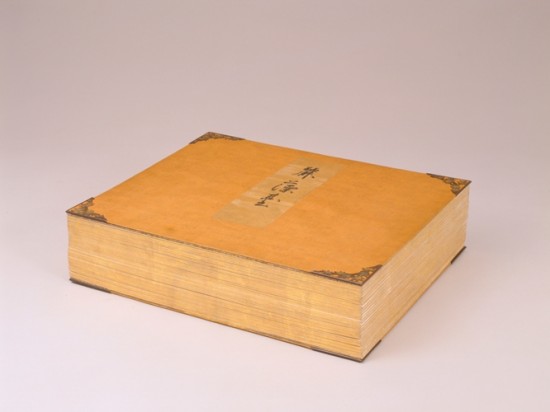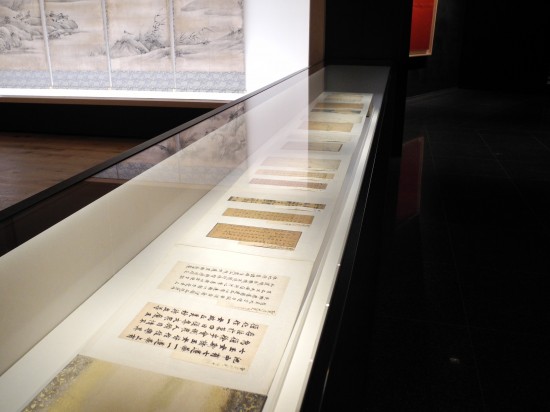From Hara Museum ARC, Gunma
The exhibition Selections from the Hara Rokuro Collection, which is currently on view at the Kankai Pavilion, is nearing its end. The official closing date is Wednesday, June 1; however, two extra days, June 4 (Saturday) and Sunday, June 5 (Sunday), will be available for viewing the show.
Though ink paintings form the core of Selections from the Hara Rokuro Collection Part II, one item of particular interest is the Reisodai, a collection (tekagami) of exemplary calligraphy dating from the Nara era to the Muromachi era, comprising some 190 excised segments (kohitsugire) from various sources.
In general, tekagami consists of the segments of books and scrolls of sutras and waka poetry, which were pasted onto thicker pages that were folded accordion style and made into albums.

Book of model handwriting, called “Reiso-dai”(cover)
Kohitsu is the term for pre-modern-era calligraphic texts that include handwritten manuscripts and books of poetry in the kana script. Segments taken from these sources are referred to as kohitsugire, kire or dankan. One factor behind the high value placed on kohitsu is the tea ceremony. Daimyo and rich merchants built tea ceremony houses and decorated their tokonoma with rare works of calligraphy in the form of hanging scrolls. As a result, kohitsu came to be admired and a great demand for kohitsu albums and collections (tekagami) arose during the Edo period.
The present exhibition features 16 kohitsugire, taken from the beginning of such tekagami collections. In the typical tekagami, it was normal for the Great Shomu attributed to Emperor Shomu to be placed before the Cho tori shitae kyo attributed to Empress Komyo.

The Great Shomu (oshomu) is a hand-copied manuscript ascribed to Emperor Shomu consisting of the Sutra of the Wise and Foolish (Kengukyozankan). It is called the Great Shomu because of the large size and boldness of its characters. Hand-copied sutras (shakyo) were typically written with 17 characters per line. In the Great Shomu, however, there are at most 12 to 13 characters to a line, and as few as 9. The Great Shomu section of the Reisodai consists of 12 characters per line. It was kept at Todaiji Temple of Yamato Province (present day Nara) and is thus called the Yamatogire.
The Cho tori shitae kyo, a segment from the Lotus Sutra, is attributed to Empress Komyo. The manuscript has gold ruled lines and a graceful calligraphic style. Butterflies, birds and plants are beautifully painted with gold and silver paint, making the decorative qualities of the paper a focus of interest aside from the calligraphy itself.
In addition to the above, other named works of kohitsugire are on display, making this a rare opportunity to enjoy some of the most exquisite examples of the calligraphic art of East Asia.
———————————-
HARA MUSEUM ARC SPRING EXHIBITIONS
◆Kankai Pavilion (traditional East Asian art)
Selections from the Hara Rokuro Collection
Part II: April 29 (Fri./ National Holiday) – June 1 (Wed.), 4 (Sat.) and 5(Sun.)
◆Contemporary Art Galleries A, B and C
Cosmos: Selections from the Hara Museum Collection
Dates: March 26 (Sat.) – June 26 (Sun.)
Closed: Thursday
* Subject to temporary closing in the event of severe weather.
Opening Hours
*Please click http://www.haramuseum.or.jp (website)
http://mobile.haramuseum.or.jp (mobile site)
———————————-
ACCESS
◇By Train◇
By JR Joetsu・Nagano Shinkansen
Recommended timetable
・10:12 Depart Tokyo Station→11:01 Arrive at Takasaki Station/ 11:11Depart Takasaki Satation→11:35 Arrive at Shibukawa Station
・11:12 Depart Tokyo Station→12:03 Arrive at Takasaki Station/ 12:20 Depart Takasaki Satation→12:44 Arrive at Shibukawa Station
・12:24 Depart Tokyo Station→13:14 Arrive at Takasaki Station/ 13:31 Depart Takasaki Satation→13:56 Arrive at Shibukawa Station
By JR Joetsu Limited Express Kusatsu
・9:00 Depart Ueno Station→10:37 Arrive at Shibukawa Station (No.31 ; operates only on Saturdays, Sundays and holidays)
・10:00 Depart Ueno Station→11:43 Arrive at Shibukawa Station (No.3 ; during April, operates only on Saturdays, Sundays and holidays))
・12:00 Depart Ueno Station→13:45 Arrive at Shibukawa Station (No. 5 ; during April, operates only on Saturdays, Sundays and holidays)
From Shibukawa Station, take the Kan-etsu Kotsu Bus and get off at the station “Green Bokujo Mae.” http://www.kan-etsu.net/r-bus/timetable/shibu-ikaho-1.htm (in Japanese only). ARC is about 7 minute walk from the bus station.
◇By Car◇
Take the Kan-etsu Expressway to Shibukawa Ikaho Interchange. Go in the direction of Ikaho Onsen for 8 km (about 15 min.) .
Highway information:
E-NEXCO Drive Plaza http://www.driveplaza.com/ (in Japanese only)
